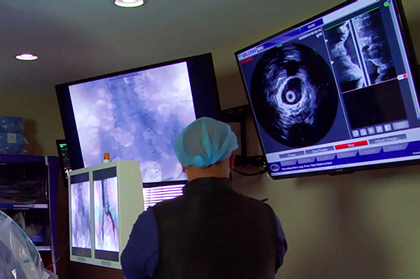Courtesy of Dr. Gustavo Leiva.

Unprotected left main PCI continues to be a challenging procedure. The use of intravascular ultrasound (IVUS) contributes important information on lesion degree, and vascular diameter.
The goal of this study was to assess the clinical impact of intravascular ultrasound in patients undergoing unprotected left main PCI using data from the Swedish Coronary Angiography and Angioplasty Registry (SCAAR). It included patients undergoing left main PCI (with stable coronary heart disease or cute coronary syndrome) between January 2005 and October 2014. The study did not include patients with prior heart surgery, Killip class III – IV during procedure, complications or death in the cath lab, and stent diameter ˂3.
The final end point was a combination of global mortality, restenosis and definite thrombosis (angiographically verified). Secondary end points were each of these components analyzed separately, in addition to probable thrombosis, defined as inexplicable death within 30 days.
Study population was 2468 patients. IVUS was used in 621 cases (25.2%). Patients in the IVUS group were younger (mostly men) and had shorter prior history of cardiac failure, myocardial infarction and stroke. Stent diameter was larger in the IVUS group (4 vs 3.5 mm), as was length and number of implanted stents. Fluoroscopy time and amount of contrast used was higher in the IVUS group.
Diabetes mellitus, the use of ticagrelor, more than 4 stents and complete revascularization were factors associated with the use of IVUS. Final primary combined end point was lower in the IVUS group, compared to the non IVUS group (HR 0.65; CI 95% 0.50-0.84; P= 0.001). Final secondary end point of mortality was lower in the IVUS group (HR 0.62; CI 95% 0.47-0.82: P= 0.001). Likewise, restenosis and stent thrombosis were lower.
IVUS guided left main PCI was associated with larger stent diameter, and this was associated to a lower incidence of the primary end point.
Comment:
The use of IVUS in unprotected left main PCI was associated to better outcomes, compared to angiography guided PCI. This was mainly the result of significantly lower global mortality with IVUS guided PCI.
The use of IVUS in this kind of procedures allows a more thorough assessment of lesion characteristics and vessel diameter. On the other hand, it enables the outcome assessment after procedure, and mostly prevents stent sub-expansion, known to cause stent thrombosis.
Courtesy of Dr. Gustavo Leiva.
Original Title: Intravascular Ultrasound Guidance Is Associated With Better Outcome in Patients Undergoing Unprotected Left Main Coronary Artery Stenting Compared With Angiography Guidance Alone.
Reference: Circ Cardiovasc Interv. 2017; 10:e004813. DOI: 110.1161/CIRCINTERVENTIONS.116.004813.
Subscribe to our weekly newsletter
Get the latest scientific articles on interventional cardiology
We are interested in your opinion. Please, leave your comments, thoughts, questions, etc., below. They will be most welcome.




